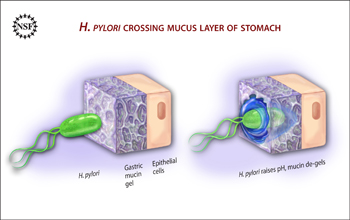All Images
News Release 09-149
Uncovering the Secrets of Ulcer-causing Bacteria
Clever biochemical strategy enables bacteria to move freely and colonize host
This material is available primarily for archival purposes. Telephone numbers or other contact information may be out of date; please see current contact information at media contacts.

Contact with stomach acid keeps the mucin lining the epithelial cell layer in a spongy gel-like state. This consistency is impermeable to the bacterium Heliobacter pylori. However, the bacterium releases urease which neutralizes the stomach acid. This causes the mucin to liquefy, and the bacterium can swim right through it.
Credit: Zina Deretsky, National Science Foundation
Download the high-resolution JPG version of the image. (687 KB)
Use your mouse to right-click (Mac users may need to Ctrl-click) the link above and choose the option that will save the file or target to your computer.
H. pylori bacterium stuck in a mucin gel at pH4. The flagella rotate but the bacterium does not move freely. But it gains motility as it increases the pH level of the mucin.
Credit: Jonathan Celli, Boston University
This video clip shows H. pylori bacteria moving around in a mucin solution at pH 6. The higher pH level means the mucin is less solid and allows greater movement for the bacteria.
Credit: Jonathan Celli, Boston University


